*On June 1, 2023 Emerson’s Climate Technologies business became a new standalone company – Copeland. Though our name has changed, we are building on more than a century of HVACR innovation and industry leadership, and Copeland continues to offer the same products, industry stewardship, and learning opportunities you’ve grown to trust. Information found on this webpage posted before June 1, 2023 may contain our old name or branding, but you can be at ease knowing it was created with the knowledge and expertise of Copeland.
In post eight of our CO2 as a Refrigerant blog series, I provide an introduction of leading CO2 commercial refrigeration architectures, including: booster and cascade systems.

Reviewing the application considerations for R-744
As I’ve explained in previous blogs in this series, the properties of R-744 affect how the refrigerant is applied. For example, it’s important to review these key concepts:
- Compared to hydrofluorocarbon (HFC) refrigerants, the high density and volumetric capacity of R-744 impact the requirement for less compressor displacement, typically ⅕ of that needed for R-404A. However, the motor size is similar, since the work requirement is approximately the same. Smaller pipe diameters are another factor impacting system design, especially on the suction side of a system.
- Because of the higher pressures of R-744, all components require a higher maximum pressure rating.
- The high discharge temperatures of R-744 (because of the high index of compression) drive the need for two-stage compression for low-temperature (LT) systems that reject heat to ambient air.
- The low critical point temperature of R-744 results in differences in system design and control.
- CO2 booster systems were called “transcritical booster” because of their ability to “transition” from subcritical to supercritical operation. In supercritical operation, the heat rejection takes place above the critical point of the refrigerant for ambient temperatures greater than 73 to 75 °F (23 to 25 °C).
In the retail sector, these properties result in R-744 being used mainly in the following types of systems:
- CO2 booster systems: As the most widely adopted CO2 system architecture around the globe, this all-CO2 system provides cooling for both LT and medium-temperature (MT) loads. The LT range is typically -30 to -4 °F (-35 to -20 °C); MT range is typically 14 to 25 °F (-10 to 4 °C). The “booster” system is designed to receive the LT compressor discharge into the MT suction, which is then discharged into a gas cooler, typically located on the roof.
- CO2 single-stage (MT condensing unit): An emerging condensing unit option globally, this simple, single-stage architecture covers MT loads while also leveraging the potential for heat reclaim when required.
- CO2 cascade: R-744 serves as the low-stage refrigerant in cascade designs, where R-744 the LT compressor discharge is always operating in its subcritical range. Heat rejected by condensing R-744 is absorbed by the evaporating high-stage refrigerant in a conventional system, which would typically be another lower-GWP A1 or A2L refrigerant option.
Due to increasing environmental regulations on refrigerants and the growing sustainability requirement, all-CO2 booster systems have emerged as the primary CO2 system architecture. The next blog in this CO2 as a Refrigerant series will take a closer look at CO2 single-stage systems.

Electrical component considerations for A2L system safety
Electrical component considerations for A2L system safety As a new refrigerant category in the...

A2L refrigerant regulation updates: what you need to know today
Preparing for the approval and safe use of A2Ls in commercial refrigeration applications The move...

Address Efficiency Mandates with Compression Technologies
Strategies for complying with DOE and ENERGY STAR® in self-contained and remote condensing units...
